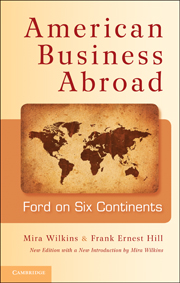Book contents
- Frontmatter
- Contents
- List of Illustrations
- Preface
- Introduction to the New Edition
- Introduction to the First Edition
- 1 First Venture
- 2 Probing for Markets
- 3 Model T: Triumph and Fable
- 4 The Alchemy of War
- 5 Steps in Expansion
- 6 The Sun Never Sets
- 7 Prosperity and Frustration
- 8 The Missionary Spirit
- 9 The Best-Laid Plans
- 10 Marriage of Convenience
- 11 Time of Desperation
- 12 A World Disturbed
- 13 Extreme of Nationalism
- 14 The British Empery
- 15 On Both Sides of World War II
- 16 The Crippled Phoenix
- 17 The New Company
- 18 Manufacturing for World Markets: From Dagenham to Geelong
- 19 New Times, New Faces, New Policies
- Appendices
- Bibliographical Essay
- Notes
- Index
- Titles in the series
- Plate section
5 - Steps in Expansion
Published online by Cambridge University Press: 05 June 2012
- Frontmatter
- Contents
- List of Illustrations
- Preface
- Introduction to the New Edition
- Introduction to the First Edition
- 1 First Venture
- 2 Probing for Markets
- 3 Model T: Triumph and Fable
- 4 The Alchemy of War
- 5 Steps in Expansion
- 6 The Sun Never Sets
- 7 Prosperity and Frustration
- 8 The Missionary Spirit
- 9 The Best-Laid Plans
- 10 Marriage of Convenience
- 11 Time of Desperation
- 12 A World Disturbed
- 13 Extreme of Nationalism
- 14 The British Empery
- 15 On Both Sides of World War II
- 16 The Crippled Phoenix
- 17 The New Company
- 18 Manufacturing for World Markets: From Dagenham to Geelong
- 19 New Times, New Faces, New Policies
- Appendices
- Bibliographical Essay
- Notes
- Index
- Titles in the series
- Plate section
Summary
Early in 1919 the Big Four framed a treaty in Paris to end the war and usher in a new era. President Woodrow Wilson for the United States, Georges Clemenceau for France, and David Lloyd George for Great Britain were really the architects, the submissive Italian Prime Minister Vittorio Orlando acquiescing in their decisions. Wilson had sailed for Europe with the hope of building a better world, but found himself too often borne down by the adroit Lloyd George and the witty, savage (“the Tiger”) Clemenceau, the latter especially dedicated to the destruction of German power. The result, in the words of the economist John Maynard Keynes, was “a Carthaginian peace.” The Germans on June 28, 1919, signed the Treaty of Versailles, admitting “war guilt,” surrendering large sections of German territory, agreeing to what would become impossible reparations, and submitting to disarmament.
As a sop Wilson had been tossed the League of Nations, through which he felt that many wrongs could be righted and world peace assured. Ironically, it was the Senate's opposition to the League that led it to reject the entire treaty. Ford had staunchly supported both the League and the Treaty. “President Wilson has done a great work worthy of the endorsement of every citizen,” his magazine, the Dearborn Independent, had proclaimed while the two were under debate, and after their rejection asserted: “The time must come when the League will be set forth in such terms as will demand the assent of the American treaty-making body. We have arrived at a side-track, not a terminus.”
- Type
- Chapter
- Information
- American Business AbroadFord on Six Continents, pp. 88 - 112Publisher: Cambridge University PressPrint publication year: 2011

